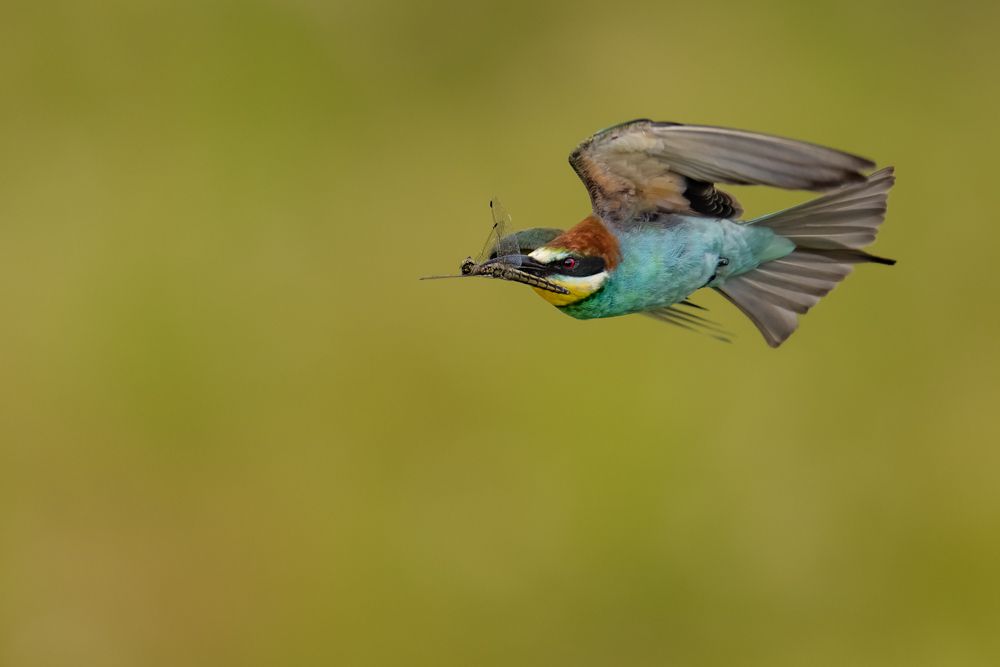Bee-eater (Merops apiaster)
Profile
Scientific name: Merops apiaster
Class: Birds
Order: Coraciiformes
Family: Bee-eaters
Length: 27-29cm
Wingspan: 44-49cm
Weight: 45-75g
Distribution: South and Southeast Europe, Northwest Africa, Southwest Asia
Breeding population CH: 100 pairs
Habitat: Open landscape
Migration behaviour: Long-distance migrant
Appearance & Identification
The bee-eater is unmistakable with its striking colouring. Males and females are not distinguishable by their appearance. The belly of the bee-eater can have a blue to turquoise colour depending on the light.
Risk of confusion
With its striking colours, the bee-eater can hardly be confused. The birds can also be easily identified in flight.
Although the starling also has triangular wings, it has considerably shorter but broader tail feathers.
Habitat
The bee-eater lives in open areas with few trees and bushes. It prefers areas with a warm climate. It digs its breeding cave in steep walls. The bee-eater finds such steep walls at riverbanks, quarries, mounds of earth or gravel pits. I myself have also been able to observe bee-eaters at an old shooting range. There, the bee-eaters have dug their breeding cave into the steep bullet trap.
Distribution in Switzerland
In Switzerland, the bee-eater used to be only observed during spring migration as a rarity. Since the 1990s, however, the bee-eater started breeding in Switzerland. The first evidence of breeding in Switzerland was in 1991 in Valais. In the last 10 years, the breeding population has increased and smaller breeding colonies have been established at various locations in Switzerland. The largest breeding colony has about 35 breeding pairs. In total the breeding population is estimated at about 100 pairs. It is very likely that the breeding population will continue to increase in the coming years.
Diet
The bee-eater is a highly specialized hunter. It feeds mainly on insects. Although bees are also part of the diet of the bee-eater, they make up only a small part of it. The bee-eater eats mainly dragonflies, beetles, moths and wasps. In order to kill them, the bee-eater beats the insects against its perch. The poison sting of bees and wasps is torn off during the process. The bird chokes out the indigestible parts of the insects. This behaviour can be observed from many predators, including kingfishers, owls and other birds of prey.
Breeding behaviour
The bee-eater breeds together with conspecifics in colonies. Instead of building a nest on a tree, the colourful bird digs a nesting hole in a steep wall of earth or soft sandstone. The female then lays between 6-7 eggs in the nest. After 20 days the young hatch. They are fed by both parents. The young bee-eaters do not leave the nesting cave until they become fully fledged. They reach flight ability 20-25 days after hatching. After leaving the nesting cave, the young bee-eaters are taken care of by their parents for a few more days, but then they have to be successful in finding food themselves. On average, a breeding pair raises between 3 and 5 young.
Migration behaviour
Bee-eaters are long-distance migratory birds, i.e. they spend the winter south of the Sahara. In spring they return to their breeding grounds. With the help of geolocators (small devices that can be used to find out the migration route) it has recently been discovered that bee-eaters migrate in family groups.
How to photograph bee-eaters
Unfortunately, without camouflage you cannot get very close to the bee-eaters. In Switzerland, all breeding sites are protected and photographing them is made even more difficult. This is because the perches are usually located in the immediate vicinity of the breeding place. Photographing the bee-eaters on their perch is therefore very difficult in Switzerland. But there is also a good reason for this. Bee-eaters are very sensitive to disturbances at their breeding grounds. Serious disturbances can cause the bee-eaters to abandon their brood.
In Leuk in Valais, however, the photographers were thought of and it is possible to photograph the beautiful birds from a relatively good distance from a hide without disturbing them in any way.
Other species
Resources
The population figures, length, weight and wingspan correspond to the data of the Vogelwarte Sempach
Information on behaviour, distribution etc. is based on my own observations and was supplemented with information from the following sources:
The Birds of Switzerland (2007) Lionel Maumary et al.
Swiss Breeding Bird Atlas 2013-2016
The Cosmos Bird Guide (2017) Lars Svensson et al.

















